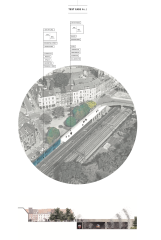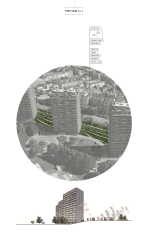While analysing the selected section of the L28 line, few observations have been made. The first one
being the difference in spatial relation between public space and railway area. Along the observed
section, spatial positioning of the rails in the vertical dimension varies from being lowered below
the level of surrounding public space, being on the same level, and being raised above. In the
horizontal dimension, the distance between accessible public space also varies. Although the
majority of the rails in the observed section is right next to public space, some segments are
separated by plots of wastelands, undeveloped green areas of varied widths or by blocks or rows of
buildings. Here, it is also important to note that in certain sections rails of the metro line go
underground. The second observation is on the edge where public space meets the railway area. Two
methods for preventing the sound of railway traffic at the edge are apparent here. The first one - by
using trees, shrubs and climbing plants, the second one - by installing walls along the edges. These
walls separate public space from railway area physically, visually and partially sonically. They act as
acoustic screens but in an attempt to suppress the sonic effects of the railway (traffic mask), they
"often reveals these sounds and may paradoxically increase dissatisfaction of inhabitants in the
protected buildings” (McCartney, Paquette, 2005). Acting as a mask itself, the wall often “hides only
to better reveal” (McCartney, Paquette, 2005). Although the goal of "peace and quiet" is used to
justify these walls (Sennett, 2017), design of them (monolith construction and/or chain-linked fence
with barbed wire on top) increases a notion of something dangerous and unpleasant being behind.
These walls create an impenetrable boundary and alienate railway area from the rest of the
surroundings. It disrupts the urban fabric of the city.
With all that said, a condition of the edge as a membrane/border rather than a boundary is, arguably,
of utmost importance. As noted by Sennett: "A noise wall-membrane is the structure or the spatial
passage which mediates between different levels of sound. <...> The membrane is the site of
heightened sensory life." (Sennett, 2017). Thus this concept of a sound wall functioning as a
membrane, either by itself or by action around them, will be the key in sonic, urban and
architectural strategies.
Sonic edge as a preventative measure for sound out of place
L28 is a railway line in the western part of Brussels. As any other transportation infrastructure it
produces noise and attempts have been made to reduce it. However, these attempts rendered the L28
line as a barrier that separated it from the rest of the city fabric. This current state is undesirable as
it segregates railway from its surroundings as well as two sides of the line. If current noise
prevention measures create such unwanted state, there is a need to rethink current tactics. Starting
from a question of what actually is noise? And how can this barrier become part of the city's urban
fabric? This will be the focus of this work.
For the clarity of this work, it is important to answer the question of "what is noise?" The description
of noise in Oxford dictionary states that noise is "a sound, especially one that is loud or unpleasant
or that causes disturbance." This is a rather vague description and implies subjectivity of the term.
Because of this subjectivity, researchers have struggled in their attempts to define noise (Pickering,
Rice, 2017). However, one definition stands out - it is a definition of noise as "sound out of place". It
stands out because it acknowledges that describing something as noise, relies on many different
circumstances.
"Sound out of place" is an application of M. Douglas' definition of dirt as "matter out of place" in
sonic studies field. By this definition of noise, it is argued that specific sounds are not inherently
noisy, but can be considered as noise if they contrast the expectation of sonic environment in
specific contexts. Because the same sound could be considered as noise or not depending on the
context, H. Pickering and T. Rice characterize noisiness as a label attached to the sound rather than
its inherent quality (Pickering, Rice, 2017). Probably one of the most important consequences of the
definition of noise as "sound out of place" is that it separates the terms noise and loudness, contrary
to the definition found in the Oxford dictionary.
So to answer the question of "what is noise?", in this project, a definition of “sound out of place" will
be used as a backbone of analysis.





